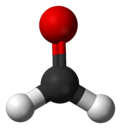
Formaldehyde

ButyraldehydeDecanalHeptanalHexanalNonanalOctadecanalOctanalPentanalPropionaldehydeFormaldehyde (systematic name methanal) is a naturally occurring organic compound with the formula CH2O (H−CHO). It is the simplest of the aldehydes (R−CHO). The common name of this substance comes from its similarity and relation to formic acid. Formaldehyde (systematic name methanal) is a naturally occurring organic compound with the formula CH2O (H−CHO). It is the simplest of the aldehydes (R−CHO). The common name of this substance comes from its similarity and relation to formic acid. Formaldehyde is an important precursor to many other materials and chemical compounds. In 1996, the installed capacity for the production of formaldehyde was estimated at 8.7 million tons per year. It is mainly used in the production of industrial resins, e.g., for particle board and coatings. In view of its widespread use, toxicity, and volatility, formaldehyde poses a significant danger to human health. In 2011, the US National Toxicology Program described formaldehyde as 'known to be a human carcinogen'. Formaldehyde is more complicated than many simple carbon compounds in that it adopts several different forms. As a gas, formaldehyde is colorless and has a characteristic pungent, irritating odor. Upon condensation, the gas converts to various other forms of formaldehyde (with different chemical formulas) that are of more practical value. One important derivative is the cyclic trimer metaformaldehyde (1,3,5-trioxane) with the formula (CH2O)3. There is also a linear polymer called paraformaldehyde. These compounds have similar chemical properties and are often used interchangeably. When dissolved in water, formaldehyde also forms a hydrate, methanediol, with the formula H2C(OH)2. This compound also exists in equilibrium with various oligomers (short polymers), depending on the concentration and temperature. A saturated water solution, of about 40% formaldehyde by volume or 37% by mass, is called '100% formalin'. A small amount of stabilizer, such as methanol, is usually added to suppress oxidation and polymerization. A typical commercial grade formalin may contain 10–12% methanol in addition to various metallic impurities. The name was genericised long ago from an old trade name, 'Formalin'. Processes in the upper atmosphere contribute up to 90% of the total formaldehyde in the environment. Formaldehyde is an intermediate in the oxidation (or combustion) of methane, as well as of other carbon compounds, e.g. in forest fires, automobile exhaust, and tobacco smoke. When produced in the atmosphere by the action of sunlight and oxygen on atmospheric methane and other hydrocarbons, it becomes part of smog. Formaldehyde has also been detected in outer space (see below). Formaldehyde and its adducts are ubiquitous in living organisms. It is formed in the metabolism of endogenous amino acids and is found in the bloodstream of humans and other primates at concentrations of approximately 0.1 millimolar. Experiments in which animals are exposed to an atmosphere containing isotopically labeled formaldehyde have demonstrated that even in deliberately exposed animals, the majority of formaldehyde-DNA adducts found in non-respiratory tissues are derived from endogenously produced formaldehyde. Formaldehyde does not accumulate in the environment, because it is broken down within a few hours by sunlight or by bacteria present in soil or water. Humans metabolize formaldehyde quickly, converting it to formic acid, so it does not accumulate in the body. Formaldehyde appears to be a useful probe in astrochemistry due to prominence of the 110←111 and 211←212 K-doublet transitions. It was the first polyatomic organic molecule detected in the interstellar medium. Since its initial detection in 1969, it has been observed in many regions of the galaxy. Because of the widespread interest in interstellar formaldehyde, it has been extensively studied, yielding new extragalactic sources. A proposed mechanism for the formation is the hydrogenation of CO ice:
